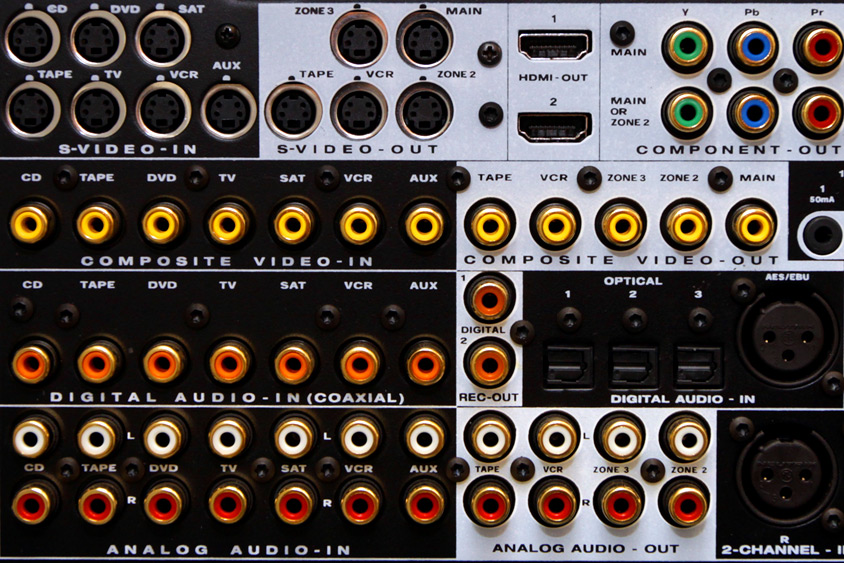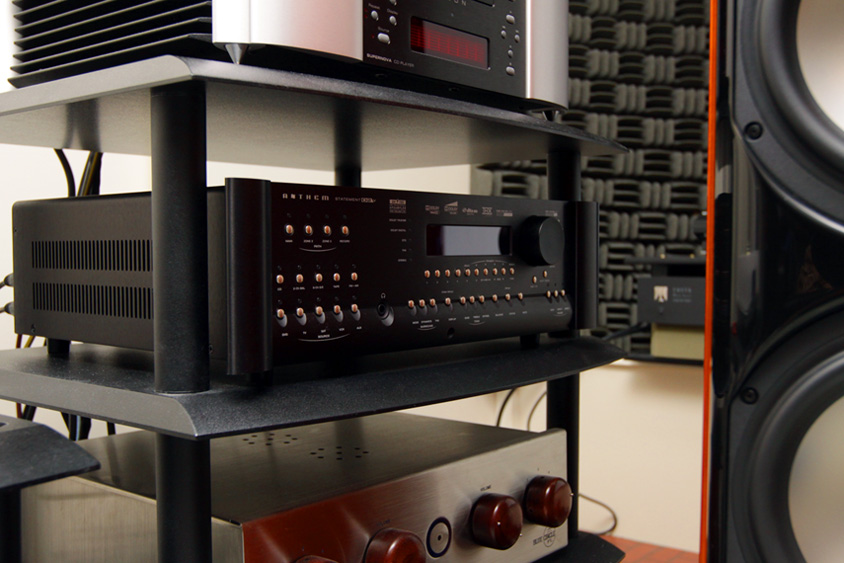 October 2009
Anthem’s Statement D2v Preamplifier-Processor:
A Bridge Between the Worlds
I usually use this space to talk about what we’re
doing at SoundStage!, or to discuss industry trends. From this month on, I also
want to use it to talk about products that I believe are breaking new ground and changing
the way we use our audio systems. This is certainly the case with Anthem’s Statement
D2v preamplifier-processor ($7499 USD). Many will think of the D2v as a home-theater
product, but it’s much more useful than that. It’s as adept with music as with
movies, and unlike most pre-pros, it allows you to blend those two worlds into a single
system while maintaining very high quality.
As a home-theater surround-sound processor, the Statement
D2v surpassed my expectations. That wasn’t really surprising -- its predecessor, the
Statement D2, was praised in many reviews, and has served as a benchmark for home-theater
processors for some time. Our sister publication Home Theater & Sound named it
the Electronics Product of the Year in 2007. The D2v is an updated,
expanded version of the D2, with additional inputs and outputs and better video
processing. Also included is Anthem’s sophisticated Anthem Room Correction (ARC)
system, which you had to pay extra for with the D2. (For an excellent look into the ARC
system, see Jeff Fritz’s "Getting Real:
Anthem Room Correction and Anthem Statement D2 Audio/Video Processor" on Ultra
Audio, another SoundStage! Network sister publication.)
The video image that the D2v sends to my projector is as
impressive as the number of options included to control and tweak it. Video-wise, I
haven’t found a thing the D2v doesn’t do well. But it was how it handled
two-channel audio that really opened my ears, and caused me to explore more possibilities
with it.
The Statement D2v has 19 inputs that can accept a digital
audio datastream: eight HDMI, seven coaxial (RCA), three optical (TosLink), and one
balanced (XLR). The only thing it lacks is USB. All incoming signals are upsampled to
24-bit/92kHz, with a resulting sound quality that’s not to quibble about.

The D2v's coaxial, optical, and XLR digital-audio
inputs can be seen in this back-panel photo.
I compared the sound of the D2v’s internal
digital-to-analog converter with that of two very good single-box DACs I had on hand, the
Stello DA220 Mk.II and the Benchmark Media Systems DAC1 HDR, and found it to be just as
good as either. I was surprised, because those DACs cost just south of $2000 each.
(Benchmark’s plain ol’ DAC1 actually lists for about $1000, a stellar bargain,
but it lacks the features of the $1895 DAC1 HDR.) They’re basically as good as you
can get without paying an insane amount of money for the state of the art -- which will
probably be only a smidgen better while costing many times as much. That kind of
performance puts the D2v in good company. Obviously, if you use the D2v’s D/A
converter, you won’t need an external DAC. That’s how I’m listening to
music right now -- one less box on my shelf, at no extra cost.
I also evaluated the Statement D2v’s preamplifier
stage. The Anthem has eight sets of stereo analog inputs -- seven singled-ended, one
balanced -- which is more than enough for most systems. It also has a built-in A/D
converter (ADC), so the inputs can actually be converted to a 24/192 digital datastream
and piped through the digital-signal-processing (DSP) section for further manipulation -- if
you want them to be. In my opinion, you’d only want the ADC in the signal path if
you were crossing your speakers over to a subwoofer (the D2v has a powerful crossover that
operates in the digital domain, so it’s quite possible you’d use it if
you’ve integrated a sub into your stereo system), or if you use Anthem’s ARC
system, or want to listen to music with one of the D2v’s music-processing modes.
Purists such as I, who like their audio untouched -- i.e., absolutely no
manipulation of any kind -- and have no sub, won’t likely opt for conversion and
processing, and we don’t have to. You can easily configure any or all of the inputs
as Analog Direct, which completely bypasses the ADC and DSP, as well as the D2v’s
tone and balance controls. (To prove that the signal is truly bypassing the digital
circuitry, Anthem says that in past demonstrations they’ve removed the demo
unit’s entire digital section while its analog preamplifier stage continued to work.)
The D2v’s Analog Direct mode is highly transparent and
very clean, which, despite all the D2v’s bells and whistles, still allows its preamp
stage to fall under the category of what old-school purists like to call the ideal
preamplifier: "a straight wire with gain." In other words, the incoming signal
is boosted but is otherwise entirely unchanged. Again, I was surprised by the quality of
the D2v’s performance as a preamp; other home-theater pre-pros I’ve tried have
sounded veiled and indistinct enough to be unusable in a true high-end audio system. And,
as with the D2v’s DAC performance, you’d have to spend a lot more to better its
preamplifier stage -- likely for something that approaches the state of the art, with a
price tag to match. For instance, Simaudio’s Moon Evolution P-7 preamplifier is just
a little bit more transparent than the D2v, letting me hear just a touch deeper into the
recording -- but it costs $6900, almost as much as the D2v, and is only a two-channel
preamp; the D2v has a zillion other options. That should give you a sense of what kind of
deal the D2v is.
Because the Statement D2v is equally adept with pure audio
and home theater, it’s changed the configuration of my home system. Whereas two
separate systems once occupied my listening space -- one for home theater, the other for
stereo, with components that sometimes crossed -- I now have a single system with the D2v
at the center, and still experience a high degree of fidelity. And because this setup is
so much more convenient, it’s actually increased my enjoyment of my system and the
amount of time I spend using it. That’s because, with the D2v in the mix, I no longer
have to go through the hassle of turning on and off multiple systems, not to mention
sometimes changing some components around. Now, with the press of a button on the remote,
I can be watching DVD or Blu-ray movies one moment, and listening to two-channel music the
next. The D2v is a high-performing bridge between the worlds of music and movies, and
it’s this strength that I don’t think has been emphasized enough in past reviews
of the product. I love this thing.

". . . the D2v is the perfect centerpiece."
But that’s not to say that I recommend that
audiophiles move en masse to a component such as the Anthem Statement D2v. I’m a
reviewer -- as much as I enjoy the D2v, I probably won’t be able to keep my systems
running this way, with all signals run through one central box. Products continue to
arrive for review, and I need separates around to be able to evaluate them properly and
fairly. Likewise, for someone who wants to chase the state of the art of audio or home
theater, doesn’t mind the inconvenience of multiple components, and has money to burn
to explore these options, separates still have their place. But for the person who wants a
system that combines home theater and two-channel, enjoys the convenience, but
wants to give up as little as possible either way; or for someone who has one type of
system, home theater or two-channel audio, and wants the potential to have both -- the D2v
is the perfect centerpiece. If I ever quit reviewing, I’d set up a system with, at
its heart, a Statement D2v or its future equivalent.
So if you were thinking of the Anthem Statement D2v as a
home-theater-only product, think again; its performance and features make it just as
relevant to audiophiles, and that’s why I think it such an important product.
It’s also a bargain. While the D2v’s $7499 price isn’t chump change, even
if you use only a few of its features, as I’m doing right now, it can still be
considered moderately priced. Take advantage of everything it offers (I’ve
only scratched the surface of its features here) and it’s actually cheap. Try to
replicate everything it does with separate components and you’ll probably end up
spending two or three times as much.
The high-performing, feature-rich Anthem Statement D2v is
one of the great products of today, with features and versatility that, tomorrow,
won’t be expected but demanded. It’s a glimpse of the future -- right now.
. . . Doug Schneider
das@soundstage.com
|

